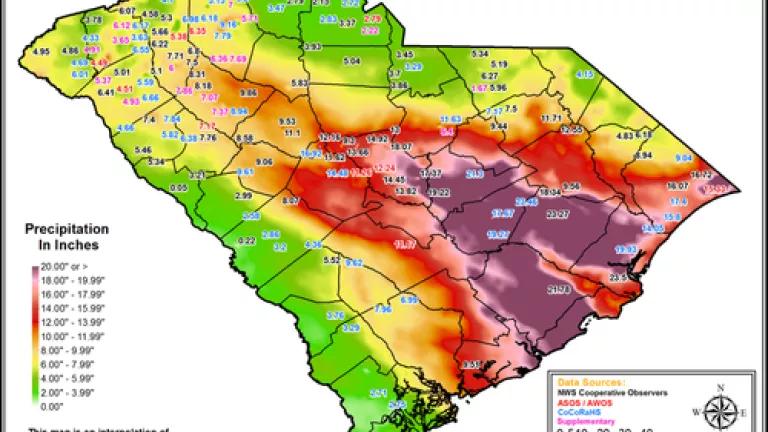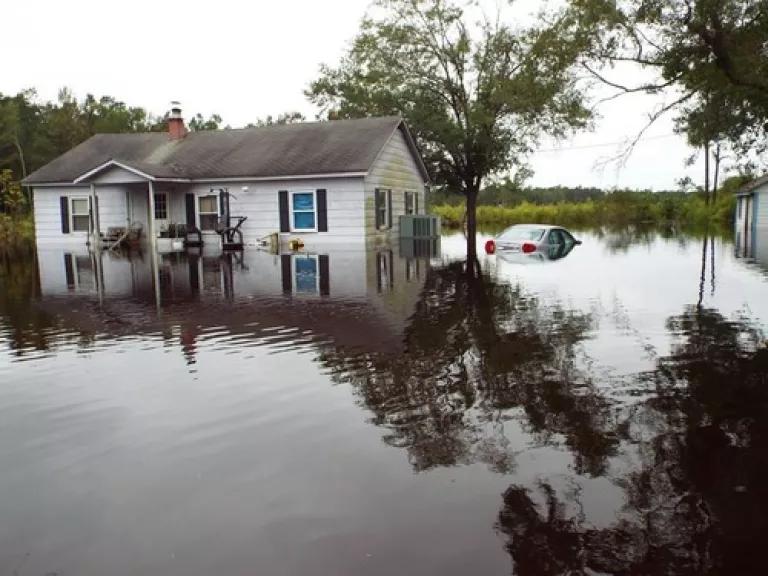
Having spent more than half my life living in South Carolina, I stared in disbelief at the video and images of submerged cars and homes, washed out streets, and rescues by boat that were broadcast on TV, the internet, and social media over the weekend. A truly unprecedented amount of rain, which exceeded more than two feet in some places, fell in the span of just a few short days. In areas of the Midlands and the Lowcountry, this extreme rainfall far exceeded that of a 1,000-year storm (or a storm that on average, we'd expect to see only once every 1,000 years!).
- Estimated rainfall totals across South Carolina (Twitter: @NWSGSP)
Unfortunately, as the risks of extreme weather, including heavy rainfall, continue to escalate due to climate change, these tragic events will likely affect other communities in the U.S. While we cannot entirely prevent damage from catastrophic floods of this magnitude, we can make concerted efforts to better protect communities in South Carolina and across the nation from these devastating impacts by more proactively preparing for future floods.
As practically a native of the Palmetto State, I have lived in or visited many of the areas hardest hit by the flooding. My in-laws' and family friends' homes and yards filled with flood waters as rivers overtopped their banks and saturated soils could not hold any more water.

- Submerged house and car in Johnsonville, SC
At the campus of my alma mater in the state's capital, Columbia, portable toilets and bottled water have been distributed, and classes have been canceled for the entire week. In many other communities across the state, water services have been disrupted, and boil water advisories have been issued as the safety of drinking water supplies have been jeopardized. While flood waters in many places have begun to recede, many downstream communities are not yet in the clear as some major rivers have yet to crest and swollen lakes and ponds have breached dams.
As the recovery and healing process begins for those so profoundly impacted by the flooding, my heart breaks for those families that are mourning the loss of loved ones and for those that lost everything and must now start over anew. Yet, my faith in humanity is renewed by the many stories of neighbors coming together to help one another.
We can take several steps to prevent similar disasters in the future:
- We can reduce the risks of critical infrastructure failing when it's needed the most by fortifying drinking water and wastewater systems against future floods and changing how we build and rebuild pump stations, service lines, and treatment plants. Currently, South Carolina's design and construction standards (similar to the commonly used Ten States Standards) only require new wastewater facilities to remain fully operational during a mere 25-year flood (or a flood that on average we expect to happen every 25 years) and be protected against physical damage from a 100-year flood. With flood risks rising across the nation, these types of flood events will only become more frequent so design standards must be strengthened. In fact, New Jersey adopted much more protective standards for these facilities after seeing many sewage treatment plants knocked offline after Superstorm Sandy.
- We can improve how we use public infrastructure funding programs like the State Revolving Funds can ensure that communities have the resources necessary to become more resilient to future flood risks and public investments in water and wastewater infrastructure are better protected against losses.
- Finally, as my colleague Joel Scata explains, robust implementation of the new Federal Flood Risk Management Standard will reduce the impact of future storms on our neighborhoods, towns, and cities.
Together these solutions can play a part in diminishing the toll that future storms and floods take on communities. We owe it to the people of South Carolina and communities in other states that have been affected by devastating flooding to take action so that the pain, suffering, and despair that many have felt is not needlessly repeated.
